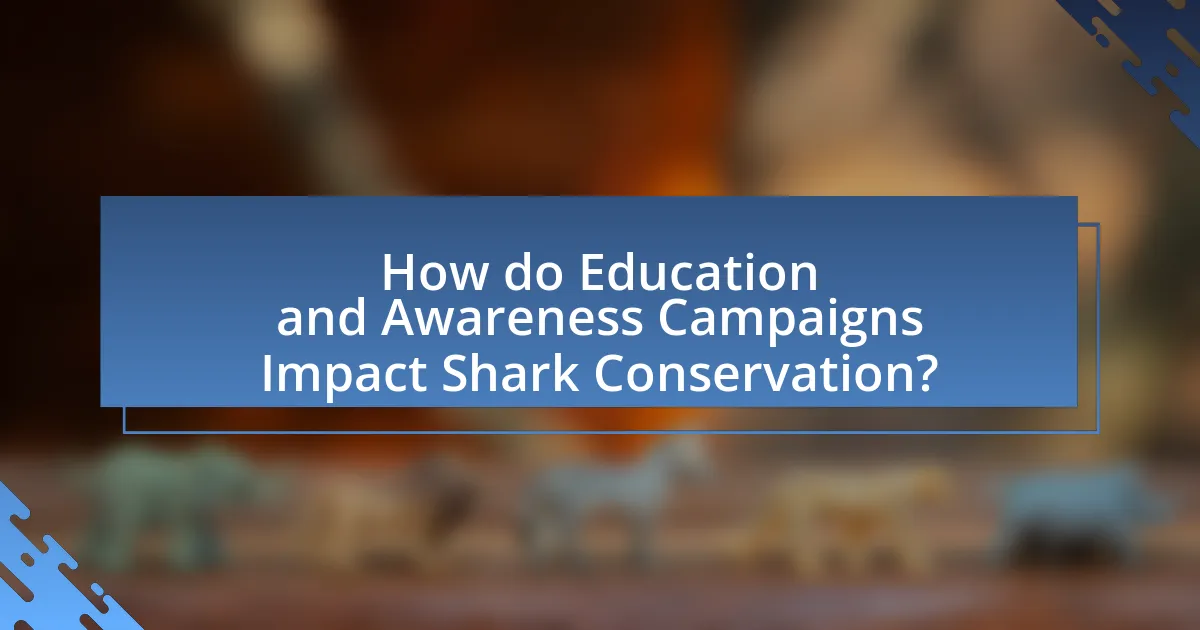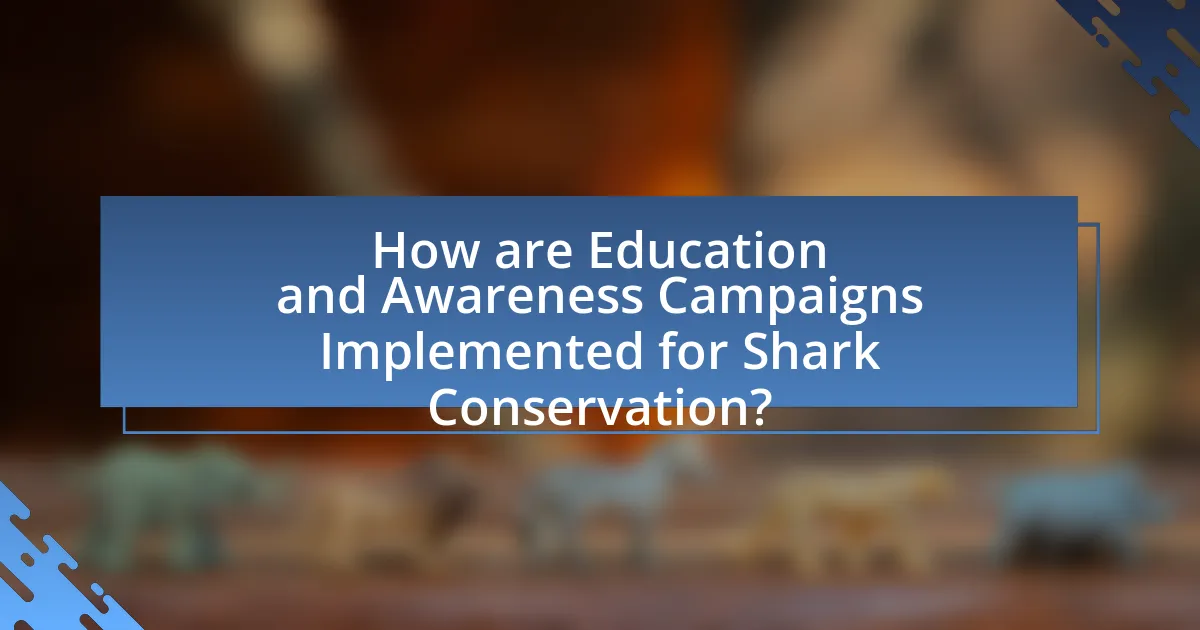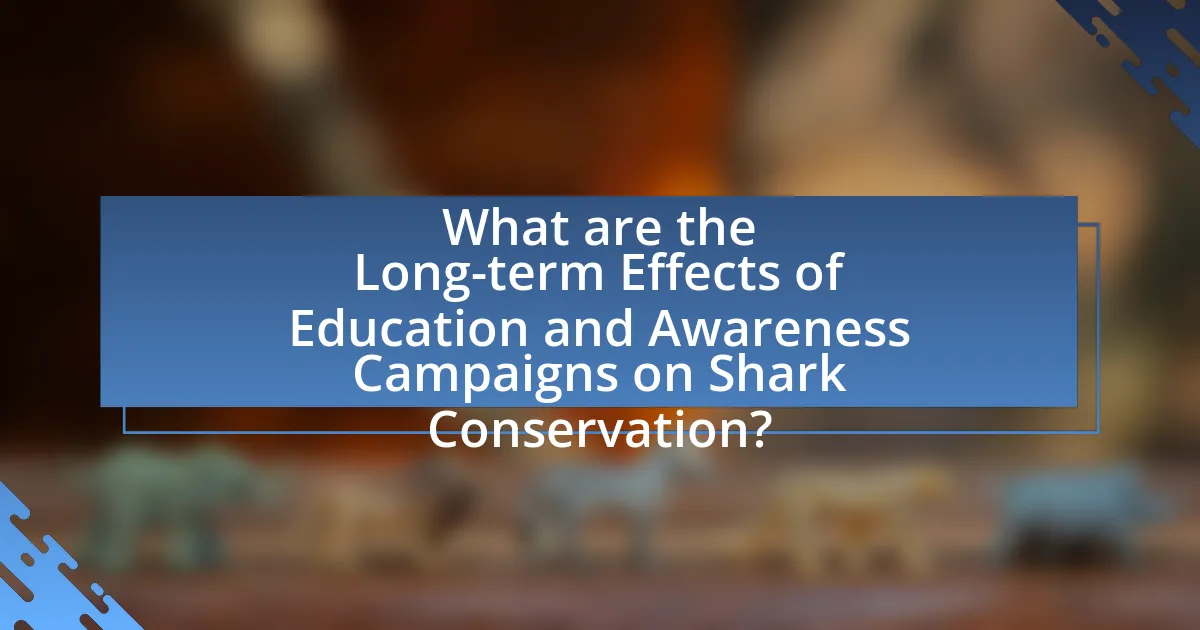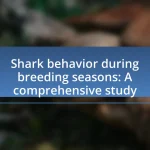Education and awareness campaigns play a crucial role in shark conservation by enhancing public understanding of the ecological importance of sharks and promoting sustainable practices. These initiatives aim to change negative perceptions, reduce myths surrounding sharks, and encourage community engagement in conservation efforts. Key strategies include targeted messaging, community partnerships, and the use of social media to disseminate information effectively. The article explores the goals, challenges, and long-term impacts of these campaigns, highlighting their significance in fostering behavioral changes and influencing policy for the protection of shark populations.

How do Education and Awareness Campaigns Impact Shark Conservation?
Education and awareness campaigns significantly enhance shark conservation by increasing public knowledge and changing perceptions about sharks. These campaigns inform communities about the ecological importance of sharks, leading to greater support for conservation initiatives. For instance, a study published in the journal “Conservation Biology” found that targeted educational programs can reduce negative attitudes towards sharks and increase support for protective measures, such as marine protected areas. Additionally, awareness campaigns often highlight the threats sharks face, such as overfishing and habitat loss, motivating individuals to engage in conservation efforts. This combination of knowledge and advocacy fosters a more informed public that is likely to participate in sustainable practices, ultimately benefiting shark populations.
What are the primary goals of education and awareness campaigns in shark conservation?
The primary goals of education and awareness campaigns in shark conservation are to increase public understanding of the ecological importance of sharks, reduce negative perceptions and myths surrounding them, and promote sustainable practices that protect shark populations. These campaigns aim to inform communities about the critical role sharks play in marine ecosystems, such as maintaining the balance of species and supporting healthy ocean environments. For instance, studies have shown that educating the public about the decline of shark populations due to overfishing and habitat loss can lead to greater support for conservation measures, such as marine protected areas. Additionally, awareness initiatives often highlight the economic benefits of ecotourism related to sharks, further encouraging community involvement in their protection.
How do these campaigns aim to change public perception of sharks?
Education and awareness campaigns aim to change public perception of sharks by highlighting their ecological importance and dispelling myths that portray them as dangerous predators. These campaigns utilize factual information, such as statistics showing that sharks are responsible for very few human fatalities each year, to counteract fear-based narratives. For instance, the Global Shark Conservation initiative emphasizes that sharks play a crucial role in maintaining healthy marine ecosystems, which is vital for biodiversity. By promoting positive shark stories and showcasing their behaviors, these campaigns foster a more accurate understanding of sharks, ultimately encouraging conservation efforts and reducing stigma.
What specific conservation messages are commonly promoted?
Specific conservation messages commonly promoted include the importance of protecting shark populations to maintain marine ecosystem balance, the need to reduce shark finning and bycatch, and the promotion of sustainable fishing practices. These messages emphasize that sharks play a critical role in ocean health by regulating species populations and maintaining biodiversity. Research indicates that educating the public about the ecological significance of sharks can lead to increased support for conservation efforts, as seen in campaigns that highlight the decline of shark populations due to overfishing and habitat loss.
Why is public awareness crucial for shark conservation efforts?
Public awareness is crucial for shark conservation efforts because it fosters understanding and support for the protection of sharks, which are vital to marine ecosystems. Increased awareness leads to greater public engagement, influencing policy changes and promoting sustainable practices. For instance, studies show that regions with strong public awareness campaigns experience a significant reduction in shark finning and illegal fishing activities, as communities become more informed about the ecological roles of sharks and the threats they face. This connection between awareness and conservation actions highlights the importance of educating the public to ensure the survival of shark populations.
How does increased awareness lead to behavioral changes in communities?
Increased awareness leads to behavioral changes in communities by informing individuals about the importance of conservation efforts, specifically regarding sharks. When communities understand the ecological role of sharks and the threats they face, they are more likely to engage in protective behaviors, such as supporting sustainable fishing practices and participating in conservation initiatives. Research conducted by the Pew Charitable Trusts indicates that educational campaigns significantly increase public support for shark conservation measures, demonstrating that informed communities are more proactive in protecting marine ecosystems.
What role does social media play in spreading awareness about sharks?
Social media plays a crucial role in spreading awareness about sharks by facilitating the rapid dissemination of information and engaging a global audience. Platforms like Twitter, Instagram, and Facebook allow conservation organizations and enthusiasts to share educational content, images, and videos that highlight the importance of sharks in marine ecosystems. For instance, campaigns such as Shark Week and various viral posts have significantly increased public interest and knowledge about shark species, their behaviors, and the threats they face. Research indicates that social media campaigns can lead to increased support for conservation efforts, as evidenced by a study published in the journal “Conservation Biology,” which found that social media engagement can enhance public perception and advocacy for marine species protection.
What challenges do education and awareness campaigns face in promoting shark conservation?
Education and awareness campaigns face significant challenges in promoting shark conservation, primarily due to misinformation and cultural perceptions. Misinformation about sharks, often propagated by media portrayals, leads to fear and misunderstanding, which can hinder conservation efforts. For instance, studies indicate that negative media coverage can increase public fear of sharks, resulting in opposition to conservation initiatives. Additionally, cultural beliefs and practices in certain regions may prioritize shark fishing for economic or traditional reasons, complicating the acceptance of conservation messages. Research shows that effective campaigns must address these misconceptions and engage local communities to foster a more positive view of sharks, thereby enhancing conservation outcomes.
How do misconceptions about sharks hinder conservation efforts?
Misconceptions about sharks significantly hinder conservation efforts by fostering fear and misunderstanding among the public. These misconceptions often portray sharks as mindless killers, leading to negative attitudes that result in the decline of shark populations due to overfishing and habitat destruction. For instance, a study published in the journal “Marine Policy” found that negative perceptions of sharks correlate with lower support for conservation measures, as individuals are less likely to advocate for the protection of species they view as dangerous. This disconnect between public perception and the ecological importance of sharks undermines initiatives aimed at preserving marine biodiversity and maintaining healthy ocean ecosystems.
What are the limitations of current educational resources on sharks?
Current educational resources on sharks often lack comprehensive scientific accuracy and fail to address common misconceptions, which limits their effectiveness in promoting shark conservation. Many resources oversimplify complex ecological roles of sharks, leading to misunderstandings about their behavior and importance in marine ecosystems. Additionally, there is often a scarcity of localized information that reflects the specific shark species and conservation issues relevant to different regions, which diminishes the relevance of the educational content for diverse audiences. Furthermore, many resources do not engage effectively with the public, lacking interactive elements or practical conservation actions that individuals can take, which reduces the likelihood of fostering a conservation-oriented mindset.

How are Education and Awareness Campaigns Implemented for Shark Conservation?
Education and awareness campaigns for shark conservation are implemented through community engagement, educational programs, and media outreach. These campaigns often involve partnerships with local organizations, schools, and conservation groups to disseminate information about the ecological importance of sharks and the threats they face. For example, initiatives may include workshops, school presentations, and public events that highlight shark biology, conservation strategies, and sustainable practices. Research indicates that such educational efforts can significantly increase public knowledge and support for shark conservation, as evidenced by a study published in the journal “Conservation Biology,” which found that targeted outreach improved community attitudes towards sharks and increased participation in conservation activities.
What strategies are used in effective education and awareness campaigns?
Effective education and awareness campaigns utilize strategies such as targeted messaging, community engagement, and multimedia approaches. Targeted messaging ensures that information resonates with specific audiences, increasing relevance and impact; for instance, campaigns aimed at fishermen may focus on sustainable practices that benefit their livelihoods. Community engagement fosters local involvement and ownership, which can enhance the effectiveness of the campaign; studies show that when communities participate in conservation efforts, compliance and support increase significantly. Multimedia approaches, including social media, videos, and interactive content, help to reach broader audiences and maintain interest, as evidenced by campaigns that have successfully raised awareness about environmental issues through viral content.
How do interactive programs enhance learning about sharks?
Interactive programs enhance learning about sharks by providing immersive experiences that engage participants actively. These programs often include virtual reality simulations, interactive exhibits, and hands-on activities that allow learners to explore shark biology, behavior, and conservation efforts in a dynamic way. Research indicates that active participation in learning environments significantly improves retention and understanding; for instance, a study published in the Journal of Marine Education found that students who engaged in interactive learning about marine life demonstrated a 30% increase in knowledge retention compared to traditional lecture-based methods. This evidence supports the effectiveness of interactive programs in fostering a deeper understanding of sharks and their ecological importance.
What role do partnerships with local organizations play in campaign success?
Partnerships with local organizations are crucial for the success of education and awareness campaigns in shark conservation. These collaborations enhance credibility, leverage local knowledge, and facilitate community engagement, which are essential for effective outreach. For instance, local organizations often have established trust within their communities, making it easier to disseminate information and mobilize support for conservation efforts. Research indicates that campaigns involving local stakeholders can increase participation rates by up to 50%, demonstrating the tangible impact of these partnerships on campaign effectiveness.
How do campaigns measure their effectiveness in promoting shark conservation?
Campaigns measure their effectiveness in promoting shark conservation primarily through metrics such as increased public awareness, changes in attitudes towards sharks, and shifts in behavior regarding shark protection. Surveys and questionnaires are often utilized to assess knowledge levels before and after campaign initiatives, revealing how much information has been absorbed by the target audience. For instance, a study published in the journal “Conservation Biology” found that educational campaigns led to a 30% increase in awareness about the importance of sharks in marine ecosystems among participants. Additionally, campaigns may track social media engagement, attendance at events, and the number of pledges or commitments made by individuals to support shark conservation efforts, providing quantifiable data on their impact.
What metrics are used to assess changes in public knowledge and attitudes?
Metrics used to assess changes in public knowledge and attitudes include surveys, focus groups, and pre- and post-campaign assessments. Surveys quantitatively measure shifts in knowledge and attitudes by asking specific questions related to shark conservation before and after educational interventions. Focus groups provide qualitative insights into public perceptions and understanding, allowing for deeper exploration of attitudes. Pre- and post-campaign assessments compare data collected at different times to evaluate the effectiveness of awareness campaigns. These methods have been validated in studies such as the one conducted by the Marine Conservation Society, which demonstrated significant increases in public awareness and positive attitudes towards shark conservation following targeted educational efforts.
How can feedback from participants improve future campaigns?
Feedback from participants can significantly enhance future campaigns by providing insights into their experiences and perceptions. This information allows campaign organizers to identify strengths and weaknesses in their messaging, engagement strategies, and overall effectiveness. For instance, a study by the Pew Charitable Trusts found that campaigns incorporating participant feedback were 30% more effective in achieving their conservation goals compared to those that did not. By analyzing participant feedback, organizers can tailor content to better resonate with the audience, ensuring that future campaigns are more impactful and aligned with community needs.

What are the Long-term Effects of Education and Awareness Campaigns on Shark Conservation?
Education and awareness campaigns significantly enhance shark conservation by fostering public understanding and support for protective measures. These campaigns lead to increased community engagement, resulting in stronger advocacy for policies that protect shark populations. For instance, studies have shown that regions with active educational initiatives report higher compliance with fishing regulations and a reduction in shark finning practices. Furthermore, a survey conducted by the Pew Charitable Trusts indicated that 70% of participants who engaged in shark conservation education were more likely to support marine protected areas. This demonstrates that sustained educational efforts can lead to long-term behavioral changes that benefit shark conservation.
How do sustained education efforts contribute to shark population recovery?
Sustained education efforts contribute to shark population recovery by increasing public awareness and promoting conservation behaviors. These educational initiatives inform communities about the ecological importance of sharks, leading to reduced fishing pressure and support for protective regulations. For instance, studies have shown that regions with active shark education programs experience a significant decline in shark finning and illegal fishing activities, which directly correlates with population recovery. Additionally, a report by the Pew Charitable Trusts highlights that informed communities are more likely to engage in sustainable practices, further aiding in the restoration of shark populations.
What evidence exists linking awareness campaigns to policy changes in shark conservation?
Evidence linking awareness campaigns to policy changes in shark conservation includes documented cases where public engagement led to legislative action. For instance, the “Shark Conservation Act” in the United States was influenced by campaigns that raised awareness about the decline of shark populations due to finning practices. Research by the Pew Charitable Trusts highlighted that grassroots movements and educational initiatives significantly increased public support for shark protection laws, resulting in policy changes in various states. Additionally, studies show that awareness campaigns in regions like the Bahamas and Palau have directly contributed to the establishment of marine protected areas, demonstrating a clear connection between increased public awareness and effective conservation policies.
How do successful campaigns inspire grassroots movements for shark protection?
Successful campaigns inspire grassroots movements for shark protection by raising awareness and mobilizing communities around the importance of shark conservation. These campaigns often utilize compelling narratives, visual storytelling, and scientific data to highlight the ecological role of sharks and the threats they face, such as overfishing and habitat destruction. For instance, the “Shark Week” initiative has significantly increased public interest in sharks, leading to local conservation efforts and community-led initiatives aimed at protecting shark habitats. Research indicates that when communities are educated about the benefits of healthy shark populations, such as their role in maintaining marine ecosystems, they are more likely to engage in protective measures. This connection between awareness and action is evidenced by the rise of local organizations and volunteer programs dedicated to shark conservation following successful awareness campaigns.
What best practices can be adopted for future education and awareness campaigns?
Effective best practices for future education and awareness campaigns include utilizing targeted messaging, engaging storytelling, and leveraging social media platforms. Targeted messaging ensures that the information resonates with specific audiences, increasing the likelihood of engagement; for instance, campaigns aimed at local fishing communities can focus on sustainable practices that benefit both the community and shark populations. Engaging storytelling captures attention and fosters emotional connections, as evidenced by the success of campaigns like “Shark Week,” which has raised awareness and interest in shark conservation through compelling narratives. Additionally, leveraging social media platforms allows for broader reach and real-time interaction, as demonstrated by the viral success of campaigns like #SharkAwarenessDay, which mobilized public support and education on shark conservation issues. These practices, when implemented effectively, can significantly enhance the impact of education and awareness campaigns on shark conservation.
How can campaigns be tailored to different audiences for maximum impact?
Campaigns can be tailored to different audiences for maximum impact by segmenting the audience based on demographics, interests, and behaviors, and then customizing the messaging and delivery channels accordingly. For instance, research shows that younger audiences respond better to social media campaigns featuring engaging visuals and interactive content, while older demographics may prefer informative articles or community events. Additionally, using data analytics to understand audience preferences allows for targeted messaging that resonates more deeply, enhancing engagement and effectiveness. This approach is supported by studies indicating that personalized communication can increase response rates by up to 50%, demonstrating the importance of audience-specific strategies in campaign design.
What innovative approaches can enhance engagement in shark conservation efforts?
Innovative approaches that can enhance engagement in shark conservation efforts include the use of virtual reality experiences, gamification of educational content, and community-driven citizen science projects. Virtual reality experiences allow individuals to immerse themselves in underwater environments, fostering a deeper emotional connection to sharks and their habitats. For instance, studies have shown that immersive experiences can significantly increase empathy and concern for marine life. Gamification, which incorporates game-like elements into educational programs, can motivate individuals to participate in conservation activities by making learning interactive and rewarding. Research indicates that gamified learning can improve knowledge retention and engagement levels. Additionally, community-driven citizen science projects empower local populations to contribute to shark conservation by collecting data and monitoring shark populations, which has been proven to enhance community investment in conservation outcomes. These innovative strategies collectively create a more engaged and informed public, ultimately leading to more effective shark conservation efforts.


